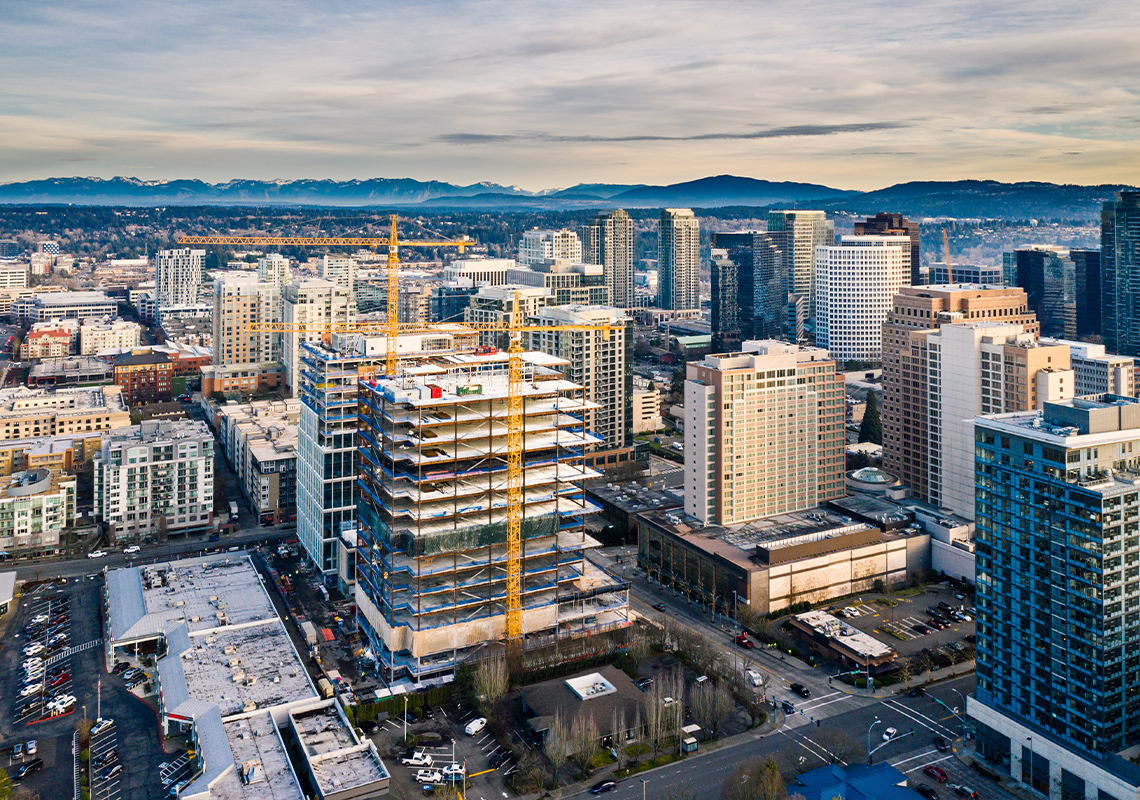By MBAKS Content Strategist James Slone
What’s driving up home prices? Supply and Demand.

Pointing out how expensive housing is has become its own
genre. How many articles do we really need on hot, hot, hot
housing markets? Is there any end in sight for breathless
reports on the monthly numbers? Probably not, because even
with recent interest rate hikes and some cooling off locally,
national home prices are still sky-high.
According to Axios, in 2022, the national median price for existing
homes rose above $400,000 for the first time in history. And that’s on
the low side for the Puget Sound region. Earlier this year, the median
home price neared one million in King County.
As of this writing, a recession lurks on the horizon and a “correction”
seems inevitable, but the market is unlikely to crash like it did
during the Great Recession. Vast numbers of Americans will remain
frozen out of the housing market, and there’s a lot of understandable
frustration and blame to go around.
There are a host of interrelated factors that have contributed to these
high prices. Let’s take a look at a few.
Shifting Demographic Sands
The story about mass flight from cities to suburbs during COVID
lockdowns may have sold online subscriptions, but it wasn’t really
true for Seattle. In fact, according to the latest census data, the bulk
of our region’s demographic growth over the last few years landed
in urbanized King County. Seattle is not dying; it’s running full
speed ahead.
Many people are trying to buy homes in popular markets like
ours, so demand for limited housing is very high. Robust urban
centers remain magnets for young professionals, and families in
the millennial cohort have entered the housing market in force.
Employers like Amazon mean a high-skilled, high-earning workforce
that can afford to buy. It also means a lot of people are priced out.
The Wages of Inequality
Many people were never priced in. Perhaps the biggest barrier to
housing in the U.S. is economic inequality. It’s not so much the price
of housing itself; it’s that earning power has not kept up. Wages
for low- to moderate-income workers have stagnated over the last
few decades and now workers have to contend with supply chain
disruptions and inflation taking a bite of their paychecks.
With low wages and high costs of living, just making rent means
never saving up. As Barron’s reported in February, “full-time workers
simply do not earn enough to make a down payment on a home” in
many U.S. housing markets—especially after COVID layoffs. On top
of this, many historically marginalized people don’t have existing
home equity or access to intergenerational wealth, making a down
payment on a home insurmountable.
Tales of Investment Capital
The old canard that Wall Street investors are responsible for high
prices is wrong, but there is a kernel of truth. As reported by Fortune in June of this year, during the COVID housing boom, investors—tempted by loose capital, low mortgages, and high appreciation—
bought up housing at record levels.
In the first quarter of 2022, “investors made up a record 28% of
single-family home sales… up from 19% in the first quarter of 2021.”
According to a study published by the Harvard Joint Center for
Housing Studies earlier this year, this single-family home shopping
spree further limited the supply for “potential owner-occupants” like
first-time buyers.
In some cases, homes have been taken off the market and turned
into rental units. As Forbes has reported, real estate investors and
landlords receive large tax breaks for houses that are not available
to live-in buyers. This has incentivized taking housing off the market.

Getting High on Supply
It’s not news that COVID led to supply chain disruptions across
the entire economy. Perhaps the most notable supply shortage for
homebuilders was in the lumber industry. In January, the National
Association of Home Builders (NAHB) reported that the rise in
lumber prices added $18,000 to the average price of single-family
homes. Other materials, such as fixtures and windows, have also
been affected by shortages, leading to construction delays and,
inevitably, higher prices.
Labor Shortage Shuffle
Ever since the Great Recession, the residential construction industry
has had a labor shortage. According to Zonda’s Ali Wolf, writing
for MarketWatch, “Many skilled workers left the housing industry
permanently as they reskilled and found jobs in other industries
perceived to be more stable.”
While the labor market has improved since then, 62% of
homebuilders report that they’re still falling short as workers
retire or switch careers. The endless search for new employees
means spending more money on salaries, recruitment, training,
and retention—not to mention costly project delays due to staffing
shortages—resulting in higher price tags.
Land and Regulations
Whether you’re a developer or a homebuilder, creating housing is
very expensive. In some of the hottest markets—like San Francisco
and Seattle—land itself is often in short supply, leading to high
land values. As explained by housing developer Benjamin Maritz in
“Meeting Great Expectations” in the fall 2021 issue of Master Builder,
to break even, developers have to charge more for fewer square feet.
And whether you’re buying a house or renting, it means paying more.
Add in regulations like lengthy permitting timelines, expensive tree
ordinances, environmental review processes, and other onerous
policies, construction becomes a very costly and time-consuming
enterprise, reducing supply and passing costs onto homebuyers.
Even policies designed to create affordable housing can produce
unintended consequences that stymie it. Seattle’s own inclusionary
zoning policy, Mandatory Housing Affordability, slapped fees and floorspace requirements on townhomes, making starter homes
ideal for first-time buyers too pricy to build. (See "The High Cost of
Regulation" in the summer 2022 issue of Master Builder.)
Supply and Demand
This brings us to the biggest, most general cause of high prices. It’s a
stone-cold classic: the law of supply and demand. Simply put, people
want homes, and there aren’t enough of them, leading to higher
prices. From 2018 to 2020, Bloomberg reports, the U.S. housing
shortage increased from 2.5 to nearly 4 million units—and the
shortage has only worsened.
According to an analysis by Pew Research published in March, “the
number of active housing listings in the U.S. was at its lowest in
at least five years in January 2022, with 408,922 active listings on
the market,” a 60% drop from 1 million listings in February 2020.
Meanwhile, single-family home prices rose from a median of $327,100
in 2019 to $408,100 in late 2021—a 25% leap!
Clearly we need supply. So, where is it?

Twilight Zoning
Along with the aforementioned permitting and environmental
review processes, which add time and uncertainty to projects, there
is also the dominance of single-family zoning in space-constrained
cities like Seattle. You can’t have housing where you can’t build it.
Some residents have even used environmental review and public
comment to scuttle needed housing.
It’s natural to ask who benefits the most from these policies. In a
2020 report on the housing crisis, Brookings fellow Jenny Schuetz
concluded the biggest beneficiaries are not builders, developers, or
investors, but existing homeowners who’ve enjoyed a substantial,
largely untaxed return on investment and the “political muscle to
continue restricting new housing supply.”
The Bottom Line
If there is one takeaway from all this, it’s that there is no one issue
to single out. Prices are driven by a complex mix of economic, social,
and political factors. But the main driver is lack of supply, and the
easiest, most direct way of addressing it is building a lot more housing
for all types for all people.
The demand is there; people want housing. It's time to embrace
solutions that support increasing supply of homes for current
residents, newcomers, and future generations.
The Master Builders Association of King and Snohomish
Counties (MBAKS) has proposed several ways to make
it easier to build, including streamlining permitting
processes, making zoning changes to facilitate more
“missing middle” housing choices in our urban areas, and
supporting workforce development to encourage people to
enter the building trades.
MBAKS also works with policymakers and housing
advocates to identify ways to create more affordable
housing and offers the Housing Toolkit to help communities pursue policies that create more
housing choices. Find out more about what MBAKS is
doing.